Pricing Guides & Dictionary of Makers Marks for Antiques & Collectibles

A few examples of appraisal values for
SARAH E
Search our price guide for your own treasures
-
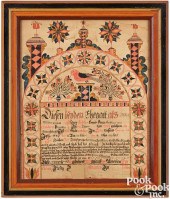 NEW JERSEY WATERCOLOR FRAKTUR BIRTH
NEW JERSEY WATERCOLOR FRAKTUR BIRTH CERTIFICATERare New Jersey ink and watercolor fraktur birth certificate for Sarah English, b. 1772, 15 1/4" x 12 1/4". Competitive in-house shipping is available for this lot.
NEW JERSEY WATERCOLOR FRAKTUR BIRTH
NEW JERSEY WATERCOLOR FRAKTUR BIRTH CERTIFICATERare New Jersey ink and watercolor fraktur birth certificate for Sarah English, b. 1772, 15 1/4" x 12 1/4". Competitive in-house shipping is available for this lot. -
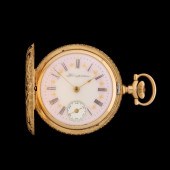 A HAMPDEN 14K GOLD POCKET WATCH
A HAMPDEN 14K GOLD POCKET WATCH WITH O'HARA DIALSerial Number: 2337279Estimated Production Year: 1907Size: 3/0sJewels: 15jMovement Configuration: HuntingMovement Finish: NickelMovement Setting: LeverPlate: Bridge PlateThe ornate hand engraved 14 karat solid gold hunter case opens to a fancy two-color O'Hara style dial with pink highlight and gold enamels as well as gold hands, the back cover opens to the Hampden Diadem 15 jewel nickel movement. A dust cover is engraved 'Sarah E. Hill 1909.'Weighs 29.4 grams.Very good condition, nice crisp engraving free from noticeable wear, no chips, cracks or repairs to the fancy enamel dial. Very good intact running condition at the time of inspection. We cannot guarantee the running or timekeeping condition of timepieces once removed from the auction premises.
A HAMPDEN 14K GOLD POCKET WATCH
A HAMPDEN 14K GOLD POCKET WATCH WITH O'HARA DIALSerial Number: 2337279Estimated Production Year: 1907Size: 3/0sJewels: 15jMovement Configuration: HuntingMovement Finish: NickelMovement Setting: LeverPlate: Bridge PlateThe ornate hand engraved 14 karat solid gold hunter case opens to a fancy two-color O'Hara style dial with pink highlight and gold enamels as well as gold hands, the back cover opens to the Hampden Diadem 15 jewel nickel movement. A dust cover is engraved 'Sarah E. Hill 1909.'Weighs 29.4 grams.Very good condition, nice crisp engraving free from noticeable wear, no chips, cracks or repairs to the fancy enamel dial. Very good intact running condition at the time of inspection. We cannot guarantee the running or timekeeping condition of timepieces once removed from the auction premises. -
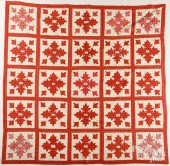 RED AND WHITE APPLIQUé FRIENDSHIP
RED AND WHITE APPLIQUé FRIENDSHIP QUILTRed and White appliqué friendship quilt, dated {1852} and signed by Amanda Roads, Emaline Harding, Sarah Eddow, etc., 97" x 97". Competitive in-house shipping is available for this lot. Condition: 6'' tear right edge. A few name squares with holes. Minor staining. A couple other holes. Two squares possibly with later appliqués. Many blocks, sashing without later fabric restoration.
RED AND WHITE APPLIQUé FRIENDSHIP
RED AND WHITE APPLIQUé FRIENDSHIP QUILTRed and White appliqué friendship quilt, dated {1852} and signed by Amanda Roads, Emaline Harding, Sarah Eddow, etc., 97" x 97". Competitive in-house shipping is available for this lot. Condition: 6'' tear right edge. A few name squares with holes. Minor staining. A couple other holes. Two squares possibly with later appliqués. Many blocks, sashing without later fabric restoration. -
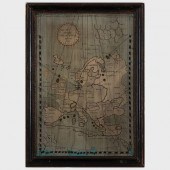 ENGLISH SCHOOLGIRL NEEDLEWORK MAP
ENGLISH SCHOOLGIRL NEEDLEWORK MAP OF EUROPEInscribed 'Sarah Evans Bristol, 1789'. 20 1/4 x 15 1/2 in. (frame). Condition Fading, losses overall, more extensive at edges. Some loose threads. Minor break to glass at left top corner. Otherwise apparently in good condition. Not examined out of frame.Not withstanding this report or any discussion concerning condition of a lot, all lots are offered and sold ""as is"" in accordance with our conditions of sale.
ENGLISH SCHOOLGIRL NEEDLEWORK MAP
ENGLISH SCHOOLGIRL NEEDLEWORK MAP OF EUROPEInscribed 'Sarah Evans Bristol, 1789'. 20 1/4 x 15 1/2 in. (frame). Condition Fading, losses overall, more extensive at edges. Some loose threads. Minor break to glass at left top corner. Otherwise apparently in good condition. Not examined out of frame.Not withstanding this report or any discussion concerning condition of a lot, all lots are offered and sold ""as is"" in accordance with our conditions of sale. -
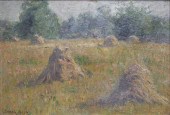 SARAH E. NASH (AMERICAN, 19/20TH
SARAH E. NASH (AMERICAN, 19/20TH CENTURY). Haystacks. Oil on canvas. Signed at lower left. From a Brooklyn, NY estate. Dimensions: 9" h x 13" w. Condition: Good. Light surface soil consistent with age.
SARAH E. NASH (AMERICAN, 19/20TH
SARAH E. NASH (AMERICAN, 19/20TH CENTURY). Haystacks. Oil on canvas. Signed at lower left. From a Brooklyn, NY estate. Dimensions: 9" h x 13" w. Condition: Good. Light surface soil consistent with age. -
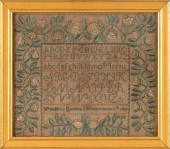 BOSTON NEEDLEWORK SAMPLER AND
BOSTON NEEDLEWORK SAMPLER AND MANUSCRIPT DOCUMENT DATED 1824 NEEDLEWORK 14" X 11.5" SIGHT. FRAMED 16" X 14". DOCUMENT UNFRAMED.BOSTON NEEDLEWORK SAMPLER AND MANUSCRIPT DOCUMENT, Dated 1824, "Wrought by Caroline Winslow in her 11th year 1824". Genealogical research indicates Caroline Winslow was born July 1813 in Boston to Edward Davis Winslow and Sarah Eliza Ancrum. Rows of alphabets and numerals, maker's inscription and a rose garland enclosed by a thin sawtooth border along three sides. Matching rose vine border on upper and side margins. Accompanied by "Improvement of Time", a handwritten essay signed "Caroline Winslow" and dated "Dedham, July 9, 1832". Dimensions: Needlework 14" x 11.5" sight. Framed 16" x 14". Document unframed.
BOSTON NEEDLEWORK SAMPLER AND
BOSTON NEEDLEWORK SAMPLER AND MANUSCRIPT DOCUMENT DATED 1824 NEEDLEWORK 14" X 11.5" SIGHT. FRAMED 16" X 14". DOCUMENT UNFRAMED.BOSTON NEEDLEWORK SAMPLER AND MANUSCRIPT DOCUMENT, Dated 1824, "Wrought by Caroline Winslow in her 11th year 1824". Genealogical research indicates Caroline Winslow was born July 1813 in Boston to Edward Davis Winslow and Sarah Eliza Ancrum. Rows of alphabets and numerals, maker's inscription and a rose garland enclosed by a thin sawtooth border along three sides. Matching rose vine border on upper and side margins. Accompanied by "Improvement of Time", a handwritten essay signed "Caroline Winslow" and dated "Dedham, July 9, 1832". Dimensions: Needlework 14" x 11.5" sight. Framed 16" x 14". Document unframed. -
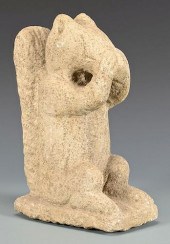 WILLIAM EDMONDSON SQUIRREL
WILLIAM EDMONDSON SQUIRREL SCULPTUREWilliam Edmondson (American/Tennessee,1884-1951) carved limestone sculpture of a squirrel, sitting on its haunches and eating a nut, atop an integral carved base. Exhibited, "William Edmondson: A Retrospective," Tennessee State Museum, 1981 (see exhibition catalog of same name, Georganne Fletcher, ed., p. 65, no. 100). Sculpture measures 12-3/4" H x 5"W x 8"D. Provenance: The collection of Robert and Deborah Street of Nashville, a gift from the artist to the late Mrs. Claude P. Street. Edmondson's sister, Sarah, worked for the Streets, and the artist was a frequent visitor to their home. He gave this sculpture as a gift to Mrs. Street for her garden, where it remained for many years. Street family members exhibited a photograph of Sarah Edmondson in the same exhibit (see exhibit catalog, p. 92, no. 112). Affidavit from family members is included with this lot, along with additional paperwork related to the exhibition loan. Biography: William Edmondson was born in Davidson County, Tennessee, the son of freed slaves, and worked most of his life as a railroad employee and janitor. A spiritual experience at the age of 57 prompted him to begin sculpting limestone using a railroad spike as chisel, and he claimed divine inspiration for the works produced during his 17 year art career. Biblical figures, women, and animals were frequent subjects, although he also produced more utilitarian items such as tombstones and birdbaths. In 1937, Edmondson became the first African American to receive a solo exhibition at the Museum of Modern Art. He is regarded as one of the most important self-taught artists of the 20th century. Condition: Surface weathering, small chips and roughness consistent with the medium and as made.
WILLIAM EDMONDSON SQUIRREL
WILLIAM EDMONDSON SQUIRREL SCULPTUREWilliam Edmondson (American/Tennessee,1884-1951) carved limestone sculpture of a squirrel, sitting on its haunches and eating a nut, atop an integral carved base. Exhibited, "William Edmondson: A Retrospective," Tennessee State Museum, 1981 (see exhibition catalog of same name, Georganne Fletcher, ed., p. 65, no. 100). Sculpture measures 12-3/4" H x 5"W x 8"D. Provenance: The collection of Robert and Deborah Street of Nashville, a gift from the artist to the late Mrs. Claude P. Street. Edmondson's sister, Sarah, worked for the Streets, and the artist was a frequent visitor to their home. He gave this sculpture as a gift to Mrs. Street for her garden, where it remained for many years. Street family members exhibited a photograph of Sarah Edmondson in the same exhibit (see exhibit catalog, p. 92, no. 112). Affidavit from family members is included with this lot, along with additional paperwork related to the exhibition loan. Biography: William Edmondson was born in Davidson County, Tennessee, the son of freed slaves, and worked most of his life as a railroad employee and janitor. A spiritual experience at the age of 57 prompted him to begin sculpting limestone using a railroad spike as chisel, and he claimed divine inspiration for the works produced during his 17 year art career. Biblical figures, women, and animals were frequent subjects, although he also produced more utilitarian items such as tombstones and birdbaths. In 1937, Edmondson became the first African American to receive a solo exhibition at the Museum of Modern Art. He is regarded as one of the most important self-taught artists of the 20th century. Condition: Surface weathering, small chips and roughness consistent with the medium and as made. -
 JOHN F KENNEDY AUTOGRAPHED
JOHN F KENNEDY AUTOGRAPHED BOOK[Kennedy Autograph Signature] Kennedy, John F. Profiles in Courage. New York Harper & Brothers, (1956). Hardback in dust jacket SIGNED by Kennedy on title page. Cache of related material and provenance material laid in, including letter from Mary Benjamin of Walter R. Benjamin Autographs in New York to Ben Caldwell dated 23 April 1971 verifying the authenticity of the presidential autograph and stating the book is the Inaugural Edition. The previous owner_s name, úSarah E. Cowan 1956. N. Y. Cî in ink and the Caldwell book plate are on the front pastedown. An interesting but tenuous clipping is tipped to front free endpaper. 8 3/4" H x 6" W x 1 1/2" D. Provenance: The living estate of Dr. and Mrs. Benjamin H. Caldwell, Nashville, TN. (Higher-resolution photos are available at www.caseantiques.com) Condition: Book is in good condition with overall wear to and slight damage to boards. The jacket is some rubbed and has edgewear at extremities and some slight soiling.
JOHN F KENNEDY AUTOGRAPHED
JOHN F KENNEDY AUTOGRAPHED BOOK[Kennedy Autograph Signature] Kennedy, John F. Profiles in Courage. New York Harper & Brothers, (1956). Hardback in dust jacket SIGNED by Kennedy on title page. Cache of related material and provenance material laid in, including letter from Mary Benjamin of Walter R. Benjamin Autographs in New York to Ben Caldwell dated 23 April 1971 verifying the authenticity of the presidential autograph and stating the book is the Inaugural Edition. The previous owner_s name, úSarah E. Cowan 1956. N. Y. Cî in ink and the Caldwell book plate are on the front pastedown. An interesting but tenuous clipping is tipped to front free endpaper. 8 3/4" H x 6" W x 1 1/2" D. Provenance: The living estate of Dr. and Mrs. Benjamin H. Caldwell, Nashville, TN. (Higher-resolution photos are available at www.caseantiques.com) Condition: Book is in good condition with overall wear to and slight damage to boards. The jacket is some rubbed and has edgewear at extremities and some slight soiling. -
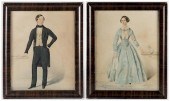 PR. KY ANTEBELLUM W/C PORTRAITSPair
PR. KY ANTEBELLUM W/C PORTRAITSPair of detailed Kentucky Antebellum watercolor portraits; inscriptions on back identify the subjects as John W. Doan and Sarah Elizabeth (Perry) Doan, with additional inscription that the works were painted Oct. 28th and November 1857 (about a month before the couple were married in Pendleton County, KY). The subjects are depicted standing in stylish attire (dark suit, blue dress), each with their hands resting atop a console table with base carved as an outstretched eagle's wing. A book rests on the table in Mr. Doan's portrait, and a vase of flowers in Miss Perry's. Both are unsigned. Each portrait is housed in an old dark grain-painted frame. 9 1/2" x 7 3/4" sight, 11 5/8" x 9 3/4" framed. Accompanying this pair of paintings is a file of genealogical information. It states that John W. Doan (alternately listed in genealogical information as Doane) was born in 1836 in Bath County, KY, to Letha Doan (father's name unknown). His wife was also born in Bath County, to Absalom and Elizabeth Perry. The Perry family were early pioneer settlers of the state. Sarah was the granddaughter of Elijah and Nancy Perry of Woodford County, KY. By 1861, John and Sarah had moved to Wildcat, Indiana. They had four children. John Perry enlisted in the 25th Infantry Regt. in 1862 and served with the Union Army. He mustered out on June 6, 1865. John Doane died in 1911 and Sarah Elizabeth Doane in 1919. They are buried in Lambirth Cemetery, Henry County, Iowa. (Higher-resolution photos are available at www.caseantiques.com) Condition: Some toning and light grime to paper, edge wear and corner losses to frame. Overall very good condition.
PR. KY ANTEBELLUM W/C PORTRAITSPair
PR. KY ANTEBELLUM W/C PORTRAITSPair of detailed Kentucky Antebellum watercolor portraits; inscriptions on back identify the subjects as John W. Doan and Sarah Elizabeth (Perry) Doan, with additional inscription that the works were painted Oct. 28th and November 1857 (about a month before the couple were married in Pendleton County, KY). The subjects are depicted standing in stylish attire (dark suit, blue dress), each with their hands resting atop a console table with base carved as an outstretched eagle's wing. A book rests on the table in Mr. Doan's portrait, and a vase of flowers in Miss Perry's. Both are unsigned. Each portrait is housed in an old dark grain-painted frame. 9 1/2" x 7 3/4" sight, 11 5/8" x 9 3/4" framed. Accompanying this pair of paintings is a file of genealogical information. It states that John W. Doan (alternately listed in genealogical information as Doane) was born in 1836 in Bath County, KY, to Letha Doan (father's name unknown). His wife was also born in Bath County, to Absalom and Elizabeth Perry. The Perry family were early pioneer settlers of the state. Sarah was the granddaughter of Elijah and Nancy Perry of Woodford County, KY. By 1861, John and Sarah had moved to Wildcat, Indiana. They had four children. John Perry enlisted in the 25th Infantry Regt. in 1862 and served with the Union Army. He mustered out on June 6, 1865. John Doane died in 1911 and Sarah Elizabeth Doane in 1919. They are buried in Lambirth Cemetery, Henry County, Iowa. (Higher-resolution photos are available at www.caseantiques.com) Condition: Some toning and light grime to paper, edge wear and corner losses to frame. Overall very good condition. -
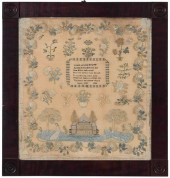 LARGE AMERICAN PICTORIAL
LARGE AMERICAN PICTORIAL NEEDLEWORKprobably Pennsylvania, 1826, center pious verse signed "Sarah Ellis 1826" within square reserve over park scene with domed building and seated female with trees, birds, and squirrel, surrounded by floral sprays and birds, floral vine inner border with satin ribbon outer border, rosettes in corner, probably original rosewood veneered frame with applied rosette corners, 30 x 28-1/2 in. Provenance: Sotheby's, New York, The Theodore H. Kapnek Collection of American Samplers, January 31, 1981, lot 114; Private Collection, Middleburg, Virginia Condition: pest damage to silk threads and major losses and wear to satin ribbon, overall toning and losses to gauze ground especially to upper right and left borders, discoloration to silk due to fading and fugitive dyes, stitched to later muslin cover board backing, framed with cracks and wear to veneer, not examined out of frame
LARGE AMERICAN PICTORIAL
LARGE AMERICAN PICTORIAL NEEDLEWORKprobably Pennsylvania, 1826, center pious verse signed "Sarah Ellis 1826" within square reserve over park scene with domed building and seated female with trees, birds, and squirrel, surrounded by floral sprays and birds, floral vine inner border with satin ribbon outer border, rosettes in corner, probably original rosewood veneered frame with applied rosette corners, 30 x 28-1/2 in. Provenance: Sotheby's, New York, The Theodore H. Kapnek Collection of American Samplers, January 31, 1981, lot 114; Private Collection, Middleburg, Virginia Condition: pest damage to silk threads and major losses and wear to satin ribbon, overall toning and losses to gauze ground especially to upper right and left borders, discoloration to silk due to fading and fugitive dyes, stitched to later muslin cover board backing, framed with cracks and wear to veneer, not examined out of frame -
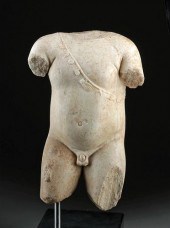 PUBLISHED / EXHIBITED ROMAN
PUBLISHED / EXHIBITED ROMAN MARBLE TORSO OF NUDE YOUTHRoman, Imperial, ca. 1st to 2nd century CE. A finely carved marble torso of a youth with an appropriately fleshy body, nude save the fascinating cord of amulets over his right shoulder. Delineated in bas relief, we see numerous dangling charms including crescents, clovers, leaves, a double axe, a right hand, a dolphin, and a phallus or capsule-shaped object. According to Sarah E. Cox, curator of the exhibition entitled "Dressed to Kill in Love and War: Splendor in the Ancient World" which included this piece, "Such charms were given to children shortly after birth to provide protection against bad luck, illness, or the evil eye, and seem to have been worn for around five to seven years." Size: 9.6" W x 14.25" H (24.4 cm x 36.2 cm); 19.6" H (49.8 cm) on included custom stand. The youthful body presents well-articulated fleshy contours, delineated belly button, paunchy abdomen, genitals, and buttocks. On his back, the curve of the spinal column and cleft between his buttocks are nicely rendered as well. Though a section from a larger statue, it is possible to discern that the thighs are thrust forward as if the figure is kneeling or squatting, suggesting lifelike energy. Such calculated poses intended to conjure human vitality in sculpture were inspired by the ancient Greek works of Polykleitos and became the model to which sculptors aspired in Graeco-Roman as well as later Western European art. This piece has been searched against the Art Loss Register database and has been cleared. The Art Loss Register maintains the world's largest database of stolen art, collectibles, and antiques. Provenance: East Coast collection, New York Gallery, New York City, New York, USA, acquired before 2010; published in "Dressed to Kill in Love and War: Splendor in the Ancient World", February 1 to March 31, 2019 - Exhibition Guide, Academy Art Museum, Maryland, USA, page 9, figure 15; ex-Gorny & Mosch, Munich, Germany, auction 214, June 19, 2013, lot 9; ex-private German collection, acquired in the 1980s All items legal to buy/sell under U.S. Statute covering cultural patrimony Code 2600, CHAPTER 14, and are guaranteed to be as described or your money back. A Certificate of Authenticity will accompany all winning bids. PLEASE NOTE: Due to recent increases of shipments being seized by Australian & German customs (even for items with pre-UNESCO provenance), we will no longer ship most antiquities and ancient Chinese art to Australia & Germany. For categories of items that are acceptable to ship to Australia or Germany, please contact us directly or work with your local customs brokerage firm. Display stands not described as included/custom in the item description are for photography purposes only and will not be included with the item upon shipping. #146087 Condition: A fragment from a larger statue as shown. Protruding element on right thigh suggests a former attached attribute. Some expected surface abrasions. Earthen and mineral deposits. Nice root marks. A very special sculpture with fascinating sash with dangling amulets.
PUBLISHED / EXHIBITED ROMAN
PUBLISHED / EXHIBITED ROMAN MARBLE TORSO OF NUDE YOUTHRoman, Imperial, ca. 1st to 2nd century CE. A finely carved marble torso of a youth with an appropriately fleshy body, nude save the fascinating cord of amulets over his right shoulder. Delineated in bas relief, we see numerous dangling charms including crescents, clovers, leaves, a double axe, a right hand, a dolphin, and a phallus or capsule-shaped object. According to Sarah E. Cox, curator of the exhibition entitled "Dressed to Kill in Love and War: Splendor in the Ancient World" which included this piece, "Such charms were given to children shortly after birth to provide protection against bad luck, illness, or the evil eye, and seem to have been worn for around five to seven years." Size: 9.6" W x 14.25" H (24.4 cm x 36.2 cm); 19.6" H (49.8 cm) on included custom stand. The youthful body presents well-articulated fleshy contours, delineated belly button, paunchy abdomen, genitals, and buttocks. On his back, the curve of the spinal column and cleft between his buttocks are nicely rendered as well. Though a section from a larger statue, it is possible to discern that the thighs are thrust forward as if the figure is kneeling or squatting, suggesting lifelike energy. Such calculated poses intended to conjure human vitality in sculpture were inspired by the ancient Greek works of Polykleitos and became the model to which sculptors aspired in Graeco-Roman as well as later Western European art. This piece has been searched against the Art Loss Register database and has been cleared. The Art Loss Register maintains the world's largest database of stolen art, collectibles, and antiques. Provenance: East Coast collection, New York Gallery, New York City, New York, USA, acquired before 2010; published in "Dressed to Kill in Love and War: Splendor in the Ancient World", February 1 to March 31, 2019 - Exhibition Guide, Academy Art Museum, Maryland, USA, page 9, figure 15; ex-Gorny & Mosch, Munich, Germany, auction 214, June 19, 2013, lot 9; ex-private German collection, acquired in the 1980s All items legal to buy/sell under U.S. Statute covering cultural patrimony Code 2600, CHAPTER 14, and are guaranteed to be as described or your money back. A Certificate of Authenticity will accompany all winning bids. PLEASE NOTE: Due to recent increases of shipments being seized by Australian & German customs (even for items with pre-UNESCO provenance), we will no longer ship most antiquities and ancient Chinese art to Australia & Germany. For categories of items that are acceptable to ship to Australia or Germany, please contact us directly or work with your local customs brokerage firm. Display stands not described as included/custom in the item description are for photography purposes only and will not be included with the item upon shipping. #146087 Condition: A fragment from a larger statue as shown. Protruding element on right thigh suggests a former attached attribute. Some expected surface abrasions. Earthen and mineral deposits. Nice root marks. A very special sculpture with fascinating sash with dangling amulets. -
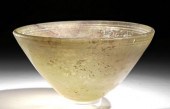 PUBLISHED LARGE ROMAN GLASS MASTOID
PUBLISHED LARGE ROMAN GLASS MASTOID BOWLRoman, early Imperial Period, ca. 1st century CE. A gorgeous mold-made, translucent glass bowl of a pale green hue with occasional bands of dark purple-red near the rim. It has a rounded base, gradually-expanding walls decorated with a trio of horizontal wheel-cut striations, and an unpronounced rim that was ground until smooth to the touch. This type of mastoid-shaped vessel was likely used for drinking wine based on the elegant and uncomplicated presentation. A fabulous example from the early Roman Empire! Size: 6.25" W x 3.5" H (15.9 cm x 8.9 cm) Published in "Glasses of Antiquity", Sarah E. Cox and Constantin E. Marinescu, New York, 2002. Provenance: private East Coast collection, New York, New York, USA, acquired before 2010 All items legal to buy/sell under U.S. Statute covering cultural patrimony Code 2600, CHAPTER 14, and are guaranteed to be as described or your money back. A Certificate of Authenticity will accompany all winning bids. PLEASE NOTE: Due to recent increases of shipments being seized by Australian & German customs (even for items with pre-UNESCO provenance), we will no longer ship most antiquities and ancient Chinese art to Australia & Germany. For categories of items that are acceptable to ship to Australia or Germany, please contact us directly or work with your local customs brokerage firm. Display stands not described as included/custom in the item description are for photography purposes only and will not be included with the item upon shipping. #146576 Condition: Intact, with light deposits on the surface. Old collection sticker on interior. This vessel does not possess a pontil mark, indicating that it was mold made rather than free blown.
PUBLISHED LARGE ROMAN GLASS MASTOID
PUBLISHED LARGE ROMAN GLASS MASTOID BOWLRoman, early Imperial Period, ca. 1st century CE. A gorgeous mold-made, translucent glass bowl of a pale green hue with occasional bands of dark purple-red near the rim. It has a rounded base, gradually-expanding walls decorated with a trio of horizontal wheel-cut striations, and an unpronounced rim that was ground until smooth to the touch. This type of mastoid-shaped vessel was likely used for drinking wine based on the elegant and uncomplicated presentation. A fabulous example from the early Roman Empire! Size: 6.25" W x 3.5" H (15.9 cm x 8.9 cm) Published in "Glasses of Antiquity", Sarah E. Cox and Constantin E. Marinescu, New York, 2002. Provenance: private East Coast collection, New York, New York, USA, acquired before 2010 All items legal to buy/sell under U.S. Statute covering cultural patrimony Code 2600, CHAPTER 14, and are guaranteed to be as described or your money back. A Certificate of Authenticity will accompany all winning bids. PLEASE NOTE: Due to recent increases of shipments being seized by Australian & German customs (even for items with pre-UNESCO provenance), we will no longer ship most antiquities and ancient Chinese art to Australia & Germany. For categories of items that are acceptable to ship to Australia or Germany, please contact us directly or work with your local customs brokerage firm. Display stands not described as included/custom in the item description are for photography purposes only and will not be included with the item upon shipping. #146576 Condition: Intact, with light deposits on the surface. Old collection sticker on interior. This vessel does not possess a pontil mark, indicating that it was mold made rather than free blown. -
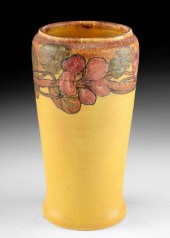 1925 SALLIE COYNE ROOKWOOD
1925 SALLIE COYNE ROOKWOOD POTTERY VASE, EX-BUTTERFIELD...Rookwood Pottery Vase by Sarah Elizabeth Coyne (1876-1939) dated 1925. Signed, numbered, and dated on base. A beautiful vellum glazed ceramic vase with a striking floral vine motif in hues of pink, green, and tawny brown with a crackle-pattern in rose around the rim, all over a golden yellow body and presenting a characteristically matte finish. Marked on the base with the Rookwood logo (a back-to-back "R" and "P" surrounded by flames), "XXV" to indicate the date 1925, identifying shape number "1657D", and a black "SEC" (Sarah Elizabeth Coyne) artist's mark. A lovely Rookwood Pottery vase of a classic form decorated with an attractive floral motif characteristic of the Arts & Crafts movement by one of Rookwood's outstanding artists, Sarah Elizabeth Coyne. Size: 4.25" in diameter x 8.125" H (10.8 cm x 20.6 cm) The Rookwood Pottery Company was founded in 1880 by the artist Maria Longworth-Nichols who created a world-renowned ceramic studio in Cincinnati, Ohio that attracted reputable artists and ceramicists. Sarah Elizabeth Coyne, who often went by "Sallie", worked at Rookwood Pottery from 1891 to 1839. Remarkably, when she began working at Rookwood, she was only 15 years old. Provenance: private Wabasha, Minnesota, USA collection; ex-Nancy and Dr. E.F. Simpson collection, Los Angeles, California, USA, acquired from 1970 to 2000 All items legal to buy/sell under U.S. Statute covering cultural patrimony Code 2600, CHAPTER 14, and are guaranteed to be as described or your money back. A Certificate of Authenticity will accompany all winning bids. PLEASE NOTE: Due to recent increases of shipments being seized by Australian & German customs (even for items with pre-UNESCO provenance), we will no longer ship most antiquities and ancient Chinese art to Australia & Germany. For categories of items that are acceptable to ship to Australia or Germany, please contact us directly or work with your local customs brokerage firm. Display stands not described as included/custom in the item description are for photography purposes only and will not be included with the item upon shipping. #171833 Condition: Marked on the base with the Rookwood logo (a back-to-back "R" and "P" surrounded by flames), "XXV" to indicate the date 1925, identifying shape number "1657D", and a black "SEC" (Sarah Elizabeth Coyne) artist's mark. An old Butterfield & Butterfield tag is attached. Slight remains of museum putty on base. Overall intact and excellent.
1925 SALLIE COYNE ROOKWOOD
1925 SALLIE COYNE ROOKWOOD POTTERY VASE, EX-BUTTERFIELD...Rookwood Pottery Vase by Sarah Elizabeth Coyne (1876-1939) dated 1925. Signed, numbered, and dated on base. A beautiful vellum glazed ceramic vase with a striking floral vine motif in hues of pink, green, and tawny brown with a crackle-pattern in rose around the rim, all over a golden yellow body and presenting a characteristically matte finish. Marked on the base with the Rookwood logo (a back-to-back "R" and "P" surrounded by flames), "XXV" to indicate the date 1925, identifying shape number "1657D", and a black "SEC" (Sarah Elizabeth Coyne) artist's mark. A lovely Rookwood Pottery vase of a classic form decorated with an attractive floral motif characteristic of the Arts & Crafts movement by one of Rookwood's outstanding artists, Sarah Elizabeth Coyne. Size: 4.25" in diameter x 8.125" H (10.8 cm x 20.6 cm) The Rookwood Pottery Company was founded in 1880 by the artist Maria Longworth-Nichols who created a world-renowned ceramic studio in Cincinnati, Ohio that attracted reputable artists and ceramicists. Sarah Elizabeth Coyne, who often went by "Sallie", worked at Rookwood Pottery from 1891 to 1839. Remarkably, when she began working at Rookwood, she was only 15 years old. Provenance: private Wabasha, Minnesota, USA collection; ex-Nancy and Dr. E.F. Simpson collection, Los Angeles, California, USA, acquired from 1970 to 2000 All items legal to buy/sell under U.S. Statute covering cultural patrimony Code 2600, CHAPTER 14, and are guaranteed to be as described or your money back. A Certificate of Authenticity will accompany all winning bids. PLEASE NOTE: Due to recent increases of shipments being seized by Australian & German customs (even for items with pre-UNESCO provenance), we will no longer ship most antiquities and ancient Chinese art to Australia & Germany. For categories of items that are acceptable to ship to Australia or Germany, please contact us directly or work with your local customs brokerage firm. Display stands not described as included/custom in the item description are for photography purposes only and will not be included with the item upon shipping. #171833 Condition: Marked on the base with the Rookwood logo (a back-to-back "R" and "P" surrounded by flames), "XXV" to indicate the date 1925, identifying shape number "1657D", and a black "SEC" (Sarah Elizabeth Coyne) artist's mark. An old Butterfield & Butterfield tag is attached. Slight remains of museum putty on base. Overall intact and excellent. -
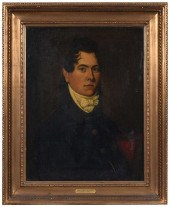 IMPORTANT VIRGINIA
IMPORTANT VIRGINIA PORTRAIT(American School, 19th Century) John Mason McCarty (1795-1852), not visibly signed, oil on canvas, 26 x 20 in.; gilt wood frame, 33-1/2 x 27-1/4 in. Provenance: Descended in the family of the consignor who traces their roots through the sitter to founding father, George Mason IV; Private Collection, Asheville, North Carolina Note: John Mason “Jack” McCarty was born on March 14, 1795 at Cedar Grove, a large plantation on Virginia’s Northern Neck at the confluence of the Accotink Creek into the Pohick Bay. Jack was the second youngest of eleven children, ten of whom were sons, born to Colonel Daniel Ball McCarty II and Sarah Eilbeck Mason. Descended from Irish nobility, his paternal grandmother and George Washington were cousins, and his maternal grandfather was founding father, George Mason IV. Jack received his primary education from private tutors and later attended George Town Academy. He briefly attended the College of New Jersey at Princeton before the War of 1812 where he served in the 60th Regiment of the Virginia Militia under the command of Lt. Col. Nicholas Minor. Sometime after the war, he was promoted to the rank of Captain. In late 1814, he returned to the College of William and Mary with his brothers Howard and William, completing his undergraduate studies and earning his law degree. Jack stood at six feet with dark wavy hair and piercing bright eyes. He was known for his ready wit, excellent memory, and was said to demonstrate an inexhaustible flow of spirits. In 1818, he was elected as a delegate to the Virginia legislature but resigned his seat before taking his oath of office as a result of violating Virginia’s Anti Dueling Act. After his duel with Armistead Mason, Jack fled to New York City, where he remained for the better part of a year before returning to his hometown. He married Lucinda Lee in December 1820, and the couple ultimately settled along the banks of the Potomac on the lands he inherited from his father. There, he built a fine home for their small family and established a horse farm, with hay being the only crop grown. In Leesburg, he built a large mill on the banks of the Tuscarora creek and opened a hotel in Washington City he named the American Hotel. He was a major investor in the C&O canal and in the construction of other canals in western territories. By 1830, Jack had been promoted to colonel in the Virginia militia and was a respected attorney, politician, and businessman in the region. Jack’s business ventures paled in comparison to the investments he made in land speculation in the western territories. He traveled extensively to the Indian territories of the northwest, making investments in both Wisconsin and Michigan, and was responsible for investments in Milwaukee, Green Bay and Detroit, and the establishment of the towns of Menasha and Neenah in Wisconsin. Jack became a leader in the Whig party and the head of the Young Whig fraction. He served one term in the Virginia legislature from 1834-1835 and campaigned for the House of Representative in 1842, an election he lost. He remained active in politics until his death, which occurred while on a business trip to Detroit in 1852. He was initially buried in Leesburg but reinterred in Hollywood Cemetery in Richmond to be laid by Lucinda’s side at her death shortly thereafter. Our thanks to author Sharon Virts for this biographical note Condition: linen backed, new stretchers, modern varnish coat may obscure some retouch, areas of retouch in background; frame with some wear especially at corners
IMPORTANT VIRGINIA
IMPORTANT VIRGINIA PORTRAIT(American School, 19th Century) John Mason McCarty (1795-1852), not visibly signed, oil on canvas, 26 x 20 in.; gilt wood frame, 33-1/2 x 27-1/4 in. Provenance: Descended in the family of the consignor who traces their roots through the sitter to founding father, George Mason IV; Private Collection, Asheville, North Carolina Note: John Mason “Jack” McCarty was born on March 14, 1795 at Cedar Grove, a large plantation on Virginia’s Northern Neck at the confluence of the Accotink Creek into the Pohick Bay. Jack was the second youngest of eleven children, ten of whom were sons, born to Colonel Daniel Ball McCarty II and Sarah Eilbeck Mason. Descended from Irish nobility, his paternal grandmother and George Washington were cousins, and his maternal grandfather was founding father, George Mason IV. Jack received his primary education from private tutors and later attended George Town Academy. He briefly attended the College of New Jersey at Princeton before the War of 1812 where he served in the 60th Regiment of the Virginia Militia under the command of Lt. Col. Nicholas Minor. Sometime after the war, he was promoted to the rank of Captain. In late 1814, he returned to the College of William and Mary with his brothers Howard and William, completing his undergraduate studies and earning his law degree. Jack stood at six feet with dark wavy hair and piercing bright eyes. He was known for his ready wit, excellent memory, and was said to demonstrate an inexhaustible flow of spirits. In 1818, he was elected as a delegate to the Virginia legislature but resigned his seat before taking his oath of office as a result of violating Virginia’s Anti Dueling Act. After his duel with Armistead Mason, Jack fled to New York City, where he remained for the better part of a year before returning to his hometown. He married Lucinda Lee in December 1820, and the couple ultimately settled along the banks of the Potomac on the lands he inherited from his father. There, he built a fine home for their small family and established a horse farm, with hay being the only crop grown. In Leesburg, he built a large mill on the banks of the Tuscarora creek and opened a hotel in Washington City he named the American Hotel. He was a major investor in the C&O canal and in the construction of other canals in western territories. By 1830, Jack had been promoted to colonel in the Virginia militia and was a respected attorney, politician, and businessman in the region. Jack’s business ventures paled in comparison to the investments he made in land speculation in the western territories. He traveled extensively to the Indian territories of the northwest, making investments in both Wisconsin and Michigan, and was responsible for investments in Milwaukee, Green Bay and Detroit, and the establishment of the towns of Menasha and Neenah in Wisconsin. Jack became a leader in the Whig party and the head of the Young Whig fraction. He served one term in the Virginia legislature from 1834-1835 and campaigned for the House of Representative in 1842, an election he lost. He remained active in politics until his death, which occurred while on a business trip to Detroit in 1852. He was initially buried in Leesburg but reinterred in Hollywood Cemetery in Richmond to be laid by Lucinda’s side at her death shortly thereafter. Our thanks to author Sharon Virts for this biographical note Condition: linen backed, new stretchers, modern varnish coat may obscure some retouch, areas of retouch in background; frame with some wear especially at corners -
 ROMAN / BYZANTINE MOSAIC, BANQUET
ROMAN / BYZANTINE MOSAIC, BANQUET SCENE KIMBROS CYCLERoman, late Imperial to Byzantine period, ca. 4th to 5th century CE. A magnificent mosaic from the Kimbros cycle featuring a banquet scene of several figures surrounding a semi-recumbent female on a kline, all delineated in hundreds of colorful stone tesserae. The Kimbros cycle is a series of mosaics depicting events in the childhood and education of a young man named Kimbros, a person otherwise absent from historical record. In the far left of this panel are 2 groups of 2 letters that seem to spell "LOOS" - a reference to the name Loios, the male personification of the month of July, who may be seated to the right of the inscription. The name of Kimbros's sister, Theodora, is inscribed in Greek at the bottom of this panel, beside the name Nosos, who is the personification of sickness or disease and typically portrayed as a winged female bust. Size of mosaic: 60.75" W x 27.5" H (154.3 cm x 69.8 cm); of matrix: 62" W x 29.1" H (157.5 cm x 73.9 cm) The seated woman to the far right may be Kyrilla who is shown seated by a bed with Nosos hovering above in 2 other panels. Fifteen of the biographical panels of Kimbros are known, all in private hands. They chronicle Kimbros's life in a particularly meticulous way, showing his birth to a wealthy family, his early life and participation in activities of the household, the trials and hardships of childhood, and ultimately how he is led on the path of learning by various teachers. These impressive narrative panels are some of the only visual materials we now have depicting the Roman paideia - the rearing and education of children to help them become ideal members of the empire. Mosaics (opus tesellatum) are some of our enduring images from the Roman world, not only for their aesthetic beauty, but also because they reveal what Romans chose to depict and see every day decorating their private and public spaces. This example is abstract in its intention and presents the ancients' keen eye for design and fascination with geometry. In the Roman province of Syria, which encompassed most of the ancient Near East/Levant, mosaics seem to have developed as a popular art form relatively late, with most finds coming from the 3rd century CE or later. Syria was one of Rome's wealthiest provinces, but it was also far removed from Rome itself and Roman culture was overlaid on enduring cultural traditions from Hellenistic Greece and the great civilizations that came before it. For example, Antioch-on-the-Orontes (modern day Antakya, Turkey), was the capital of northern Roman Syria, and its excavations in the 1930s revealed more than three hundred mosaic pavements. Popular mosaic themes from this region were often mythological or religious scenes, depicting gods and goddesses; however, sometimes mosaics were created to fit the theme of a building or room. Other panels from the Kimbros cycle have been published in "'Culture's Visual Culture: The Iconography of Education and of Intellectual, Musical and Literary Pursuits in Roman Art" by Bjorn Christian Ewald in "Was Ist Bildung in Der Vormoderne?" Ed. by Peter Gemeinhardt, Pp. 109-165. Studies in Education and Religion in Ancient Pre-Modern History in the Mediterranean and Its Environs, 4., 2019, as well as 2 articles by Sarah E. Cox: "Paideia's Children: Childhood Education on a Group of Late Antique Mosaics" in Hexperia Supplement 41, 2007 and "Bringing Up Baby: Five Unpublished Panels in the Kimbros Mosaic Series" XII Colloquio AIEMA, Venezia, 11-15 September 2012, ATTI, 2015. Provenance: private New York, New York, USA collection; ex-private prominent Daryl Kulok collection, New York, USA, acquired in the 2000s All items legal to buy/sell under U.S. Statute covering cultural patrimony Code 2600, CHAPTER 14, and are guaranteed to be as described or your money back. A Certificate of Authenticity will accompany all winning bids. We ship worldwide and handle all shipping in-house for your convenience. #175472 Condition: Set in a modern plaster matrix with a metal frame. Fragment of a larger piece with losses to upper areas, as well as along left periphery. Some expected nicks and chips to tesserae. Otherwise, great remaining imagery and nice pigments.
ROMAN / BYZANTINE MOSAIC, BANQUET
ROMAN / BYZANTINE MOSAIC, BANQUET SCENE KIMBROS CYCLERoman, late Imperial to Byzantine period, ca. 4th to 5th century CE. A magnificent mosaic from the Kimbros cycle featuring a banquet scene of several figures surrounding a semi-recumbent female on a kline, all delineated in hundreds of colorful stone tesserae. The Kimbros cycle is a series of mosaics depicting events in the childhood and education of a young man named Kimbros, a person otherwise absent from historical record. In the far left of this panel are 2 groups of 2 letters that seem to spell "LOOS" - a reference to the name Loios, the male personification of the month of July, who may be seated to the right of the inscription. The name of Kimbros's sister, Theodora, is inscribed in Greek at the bottom of this panel, beside the name Nosos, who is the personification of sickness or disease and typically portrayed as a winged female bust. Size of mosaic: 60.75" W x 27.5" H (154.3 cm x 69.8 cm); of matrix: 62" W x 29.1" H (157.5 cm x 73.9 cm) The seated woman to the far right may be Kyrilla who is shown seated by a bed with Nosos hovering above in 2 other panels. Fifteen of the biographical panels of Kimbros are known, all in private hands. They chronicle Kimbros's life in a particularly meticulous way, showing his birth to a wealthy family, his early life and participation in activities of the household, the trials and hardships of childhood, and ultimately how he is led on the path of learning by various teachers. These impressive narrative panels are some of the only visual materials we now have depicting the Roman paideia - the rearing and education of children to help them become ideal members of the empire. Mosaics (opus tesellatum) are some of our enduring images from the Roman world, not only for their aesthetic beauty, but also because they reveal what Romans chose to depict and see every day decorating their private and public spaces. This example is abstract in its intention and presents the ancients' keen eye for design and fascination with geometry. In the Roman province of Syria, which encompassed most of the ancient Near East/Levant, mosaics seem to have developed as a popular art form relatively late, with most finds coming from the 3rd century CE or later. Syria was one of Rome's wealthiest provinces, but it was also far removed from Rome itself and Roman culture was overlaid on enduring cultural traditions from Hellenistic Greece and the great civilizations that came before it. For example, Antioch-on-the-Orontes (modern day Antakya, Turkey), was the capital of northern Roman Syria, and its excavations in the 1930s revealed more than three hundred mosaic pavements. Popular mosaic themes from this region were often mythological or religious scenes, depicting gods and goddesses; however, sometimes mosaics were created to fit the theme of a building or room. Other panels from the Kimbros cycle have been published in "'Culture's Visual Culture: The Iconography of Education and of Intellectual, Musical and Literary Pursuits in Roman Art" by Bjorn Christian Ewald in "Was Ist Bildung in Der Vormoderne?" Ed. by Peter Gemeinhardt, Pp. 109-165. Studies in Education and Religion in Ancient Pre-Modern History in the Mediterranean and Its Environs, 4., 2019, as well as 2 articles by Sarah E. Cox: "Paideia's Children: Childhood Education on a Group of Late Antique Mosaics" in Hexperia Supplement 41, 2007 and "Bringing Up Baby: Five Unpublished Panels in the Kimbros Mosaic Series" XII Colloquio AIEMA, Venezia, 11-15 September 2012, ATTI, 2015. Provenance: private New York, New York, USA collection; ex-private prominent Daryl Kulok collection, New York, USA, acquired in the 2000s All items legal to buy/sell under U.S. Statute covering cultural patrimony Code 2600, CHAPTER 14, and are guaranteed to be as described or your money back. A Certificate of Authenticity will accompany all winning bids. We ship worldwide and handle all shipping in-house for your convenience. #175472 Condition: Set in a modern plaster matrix with a metal frame. Fragment of a larger piece with losses to upper areas, as well as along left periphery. Some expected nicks and chips to tesserae. Otherwise, great remaining imagery and nice pigments. -
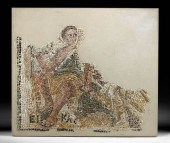 LATE ROMAN MOSAIC PANEL OF EIKAS
LATE ROMAN MOSAIC PANEL OF EIKAS FROM KIMBROS CYCLERoman, late Imperial to Byzantine period, ca. 4th to 5th century CE. A remarkable mosaic from the Kimbros cycle featuring a seated male figure in front of the robed lower body of Eikas - the female personification of the 20th day - whose name is inscribed below, all delineated in hundreds of vibrant stone tesserae. Based on other depictions of Eikas in the Kimbros cycle, this couple likely serves as an embodiment of the date with the male symbolizing a specific month. Dressed in a toga, he turns to his left, holding an object in his right hand while supporting himself with his left. This panel is from a cycle of mosaics depicting events in the childhood and education of a young man named Kimbros, a person otherwise absent from historical record. These impressive narrative panels are some of the only visual materials we now have depicting the Roman paideia - the rearing and education of children to help them become ideal members of the empire. Size (of mosaic): 30.5" W x 24.2" H (77.5 cm x 61.5 cm); (of matrix): 29.25" W x 33.26" H (74.3 cm x 84.5 cm) Fifteen of the biographical panels are known, all in private hands. They chronicle Kimbros's life in a particularly meticulous way, showing his birth to a wealthy family, his early life and participation in activities of the household, the trials and hardships of childhood, and ultimately how he is led on the path of learning by various teachers. Mosaics (opus tesellatum) are some of our enduring images from the Roman world, not only for their aesthetic beauty, but also because they reveal what Romans chose to depict and see every day decorating their private and public spaces. This example is abstract in its intention and presents the ancients' keen eye for design and fascination with geometry. In the Roman province of Syria, which encompassed most of the ancient Near East/Levant, mosaics seem to have developed as a popular art form relatively late, with most finds coming from the 3rd century CE or later. Syria was one of Rome's wealthiest provinces, but it was also far removed from Rome itself and Roman culture was overlaid on enduring cultural traditions from Hellenistic Greece and the great civilizations that came before it. For example, Antioch-on-the-Orontes (modern day Antakya, Turkey), was the capital of northern Roman Syria, and its excavations in the 1930s revealed more than three hundred mosaic pavements. Popular mosaic themes from this region were often mythological or religious scenes, depicting gods and goddesses; however, sometimes mosaics were created to fit the theme of a building or room. Other panels from the Kimbros cycle have been published in "'Culture's Visual Culture: The Iconography of Education and of Intellectual, Musical and Literary Pursuits in Roman Art" by Bjorn Christian Ewald in "Was Ist Bildung in Der Vormoderne?" Ed. by Peter Gemeinhardt, Pp. 109-165. Studies in Education and Religion in Ancient Pre-Modern History in the Mediterranean and Its Environs, 4., 2019, as well as 2 articles by Sarah E. Cox: "Paideia's Children: Childhood Education on a Group of Late Antique Mosaics" in Hexperia Supplement 41, 2007 and "Bringing Up Baby: Five Unpublished Panels in the Kimbros Mosaic Series" XII Colloquio AIEMA, Venezia, 11-15 September 2012, ATTI, 2015. Provenance: private New York, New York, USA collection; ex-private prominent Daryl Kulok collection, New York, USA, acquired in the 2000s All items legal to buy/sell under U.S. Statute covering cultural patrimony Code 2600, CHAPTER 14, and are guaranteed to be as described or your money back. A Certificate of Authenticity will accompany all winning bids. We ship worldwide and handle all shipping in-house for your convenience. #175473 Condition: Set in a modern plaster matrix with a metal frame. Fragment of a larger piece with losses to upper and right areas, as well as along peripheries. Some expected nicks and chips to some tesserae. Otherwise, great remaining imagery and nice pigments.
LATE ROMAN MOSAIC PANEL OF EIKAS
LATE ROMAN MOSAIC PANEL OF EIKAS FROM KIMBROS CYCLERoman, late Imperial to Byzantine period, ca. 4th to 5th century CE. A remarkable mosaic from the Kimbros cycle featuring a seated male figure in front of the robed lower body of Eikas - the female personification of the 20th day - whose name is inscribed below, all delineated in hundreds of vibrant stone tesserae. Based on other depictions of Eikas in the Kimbros cycle, this couple likely serves as an embodiment of the date with the male symbolizing a specific month. Dressed in a toga, he turns to his left, holding an object in his right hand while supporting himself with his left. This panel is from a cycle of mosaics depicting events in the childhood and education of a young man named Kimbros, a person otherwise absent from historical record. These impressive narrative panels are some of the only visual materials we now have depicting the Roman paideia - the rearing and education of children to help them become ideal members of the empire. Size (of mosaic): 30.5" W x 24.2" H (77.5 cm x 61.5 cm); (of matrix): 29.25" W x 33.26" H (74.3 cm x 84.5 cm) Fifteen of the biographical panels are known, all in private hands. They chronicle Kimbros's life in a particularly meticulous way, showing his birth to a wealthy family, his early life and participation in activities of the household, the trials and hardships of childhood, and ultimately how he is led on the path of learning by various teachers. Mosaics (opus tesellatum) are some of our enduring images from the Roman world, not only for their aesthetic beauty, but also because they reveal what Romans chose to depict and see every day decorating their private and public spaces. This example is abstract in its intention and presents the ancients' keen eye for design and fascination with geometry. In the Roman province of Syria, which encompassed most of the ancient Near East/Levant, mosaics seem to have developed as a popular art form relatively late, with most finds coming from the 3rd century CE or later. Syria was one of Rome's wealthiest provinces, but it was also far removed from Rome itself and Roman culture was overlaid on enduring cultural traditions from Hellenistic Greece and the great civilizations that came before it. For example, Antioch-on-the-Orontes (modern day Antakya, Turkey), was the capital of northern Roman Syria, and its excavations in the 1930s revealed more than three hundred mosaic pavements. Popular mosaic themes from this region were often mythological or religious scenes, depicting gods and goddesses; however, sometimes mosaics were created to fit the theme of a building or room. Other panels from the Kimbros cycle have been published in "'Culture's Visual Culture: The Iconography of Education and of Intellectual, Musical and Literary Pursuits in Roman Art" by Bjorn Christian Ewald in "Was Ist Bildung in Der Vormoderne?" Ed. by Peter Gemeinhardt, Pp. 109-165. Studies in Education and Religion in Ancient Pre-Modern History in the Mediterranean and Its Environs, 4., 2019, as well as 2 articles by Sarah E. Cox: "Paideia's Children: Childhood Education on a Group of Late Antique Mosaics" in Hexperia Supplement 41, 2007 and "Bringing Up Baby: Five Unpublished Panels in the Kimbros Mosaic Series" XII Colloquio AIEMA, Venezia, 11-15 September 2012, ATTI, 2015. Provenance: private New York, New York, USA collection; ex-private prominent Daryl Kulok collection, New York, USA, acquired in the 2000s All items legal to buy/sell under U.S. Statute covering cultural patrimony Code 2600, CHAPTER 14, and are guaranteed to be as described or your money back. A Certificate of Authenticity will accompany all winning bids. We ship worldwide and handle all shipping in-house for your convenience. #175473 Condition: Set in a modern plaster matrix with a metal frame. Fragment of a larger piece with losses to upper and right areas, as well as along peripheries. Some expected nicks and chips to some tesserae. Otherwise, great remaining imagery and nice pigments. -
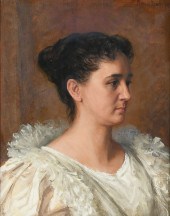 IRWIN, Benoni, (Canadian,
IRWIN, Benoni, (Canadian, 1840-1896): Portrait of Mrs. John B. Stetson (Sarah Elizabeth Shindler, who later became the wife of Count Alexi of Portugal, ''Countess de Queiroz''). Benoni was represented by the Metropolitan Museum in New York and the Corcoran Art Gallery in Washington, D.C. Oil/Canvas, 20'' x 16'', signed upper right and dated 1896, framed, 28'' x 24''. CONDITION: Needs to be varnished, several scattered touches of inpaint.
IRWIN, Benoni, (Canadian,
IRWIN, Benoni, (Canadian, 1840-1896): Portrait of Mrs. John B. Stetson (Sarah Elizabeth Shindler, who later became the wife of Count Alexi of Portugal, ''Countess de Queiroz''). Benoni was represented by the Metropolitan Museum in New York and the Corcoran Art Gallery in Washington, D.C. Oil/Canvas, 20'' x 16'', signed upper right and dated 1896, framed, 28'' x 24''. CONDITION: Needs to be varnished, several scattered touches of inpaint. -
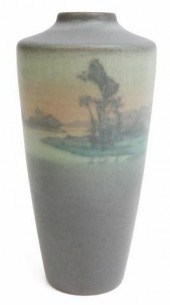 ROOKWOOD SARAH ELIZABETH COYNE
ROOKWOOD SARAH ELIZABETH COYNE VELLUM SCENIC VASEAmerican Arts and Crafts pottery vase, Rookwood, c.1913, shape number 1867, incised initials SEC (Sarah Elizabeth Coyne, American, 1891-1939), vellum glaze, decorated with water landscape, approx 7 5/8"h, 3.75"diam, 1.5lbs
ROOKWOOD SARAH ELIZABETH COYNE
ROOKWOOD SARAH ELIZABETH COYNE VELLUM SCENIC VASEAmerican Arts and Crafts pottery vase, Rookwood, c.1913, shape number 1867, incised initials SEC (Sarah Elizabeth Coyne, American, 1891-1939), vellum glaze, decorated with water landscape, approx 7 5/8"h, 3.75"diam, 1.5lbs -
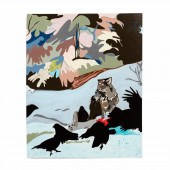 SARAH EMERSON, "DRIFT" WOLVES &
SARAH EMERSON, "DRIFT" WOLVES & CROWS O/C 2010 Sarah Emerson (American b. 1974), "Drift", 2010, acrylic on canvas, depicting a wolf in the snowy forest surrounded by crows after killing a deer, apparently unsigned, unframed. Provenance: From the Private Collection of Ruth West, Atlanta, Georgia. Approx. h. 30", w. 24.125" (canvas).
SARAH EMERSON, "DRIFT" WOLVES &
SARAH EMERSON, "DRIFT" WOLVES & CROWS O/C 2010 Sarah Emerson (American b. 1974), "Drift", 2010, acrylic on canvas, depicting a wolf in the snowy forest surrounded by crows after killing a deer, apparently unsigned, unframed. Provenance: From the Private Collection of Ruth West, Atlanta, Georgia. Approx. h. 30", w. 24.125" (canvas). -
 ROSEWOOD LAP DESK 19TH CENTURY
ROSEWOOD LAP DESK 19TH CENTURY HEIGHT 5”. WIDTH 14”. DEPTH 9.5”.ROSEWOOD LAP DESK, 19th Century, Brass plaque on top engraved "Sarah Everett Hale from her Father July 8th 1835". With contents pertaining to Edward Everett Hale including a 1905 copy of his book "The Man Without a Country". Dimensions: Height 5". Width 14". Depth 9.5".
ROSEWOOD LAP DESK 19TH CENTURY
ROSEWOOD LAP DESK 19TH CENTURY HEIGHT 5”. WIDTH 14”. DEPTH 9.5”.ROSEWOOD LAP DESK, 19th Century, Brass plaque on top engraved "Sarah Everett Hale from her Father July 8th 1835". With contents pertaining to Edward Everett Hale including a 1905 copy of his book "The Man Without a Country". Dimensions: Height 5". Width 14". Depth 9.5". -
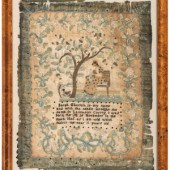 A Lancaster County Needlework
A Lancaster County Needlework Sampler, Likely from the School of Leah Bratten Galligher Meguier 1817 depicting a woman embroidering under a tree and within a floral border, reading Sarah Eberlein is my name / and with the needle wrought the / same in Lancaster County i was / born the 3rd of November in the / morn 1806 as i am told which / makes me near 11 years old. 21 x 16 1/4 inches. The sampler is described in the 1903 Biographical Annals of Lancaster County, page 1223, in the entry of Milton Wike, Sarah Eberlein's son.
A Lancaster County Needlework
A Lancaster County Needlework Sampler, Likely from the School of Leah Bratten Galligher Meguier 1817 depicting a woman embroidering under a tree and within a floral border, reading Sarah Eberlein is my name / and with the needle wrought the / same in Lancaster County i was / born the 3rd of November in the / morn 1806 as i am told which / makes me near 11 years old. 21 x 16 1/4 inches. The sampler is described in the 1903 Biographical Annals of Lancaster County, page 1223, in the entry of Milton Wike, Sarah Eberlein's son. -
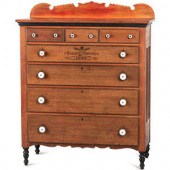 A Mennonite Red Wash, Black and
A Mennonite Red Wash, Black and Parcel Gilt Painted, Stencil Decorated Poplar Chest of Drawers Ohio or Indiana, Dated 1899 stenciled Sarah E. Troyer / 1899, bearing a black painted SM on the backboards, having glazed ceramic drawer pulls, retains a historic surface. Height 53 1/2 x width 43 1/4 x depth 20 1/4 inches. The Troyer surname is extremely common in the Mennonite communities of Holmes County, Ohio and Elkhart County, Indiana, and marriage records were located in both states that could relate to this chest. The marriage of Sarah Troyer and Eli Troyer was recorded in Holmes County, Ohio on January 12, 1900, and the marriage of Sarah Yoder and Simon Yoder of Goshen, Indiana on May 14, 1899. While a generation later, this chest shows the clear influence of chests made by the Soap Hollow, Pennsylvania Mennonite community, and is indicative of the western movement of this religious group. The shaped skirt and gallery, and use of a red and black palette, stenciled decoration and plain porcelain knobs is typical of the work of Sala and other Soap Hollow makers. The exclusive use of poplar for the chest is more typical of the Ohio Mennonite cabinet makers.
A Mennonite Red Wash, Black and
A Mennonite Red Wash, Black and Parcel Gilt Painted, Stencil Decorated Poplar Chest of Drawers Ohio or Indiana, Dated 1899 stenciled Sarah E. Troyer / 1899, bearing a black painted SM on the backboards, having glazed ceramic drawer pulls, retains a historic surface. Height 53 1/2 x width 43 1/4 x depth 20 1/4 inches. The Troyer surname is extremely common in the Mennonite communities of Holmes County, Ohio and Elkhart County, Indiana, and marriage records were located in both states that could relate to this chest. The marriage of Sarah Troyer and Eli Troyer was recorded in Holmes County, Ohio on January 12, 1900, and the marriage of Sarah Yoder and Simon Yoder of Goshen, Indiana on May 14, 1899. While a generation later, this chest shows the clear influence of chests made by the Soap Hollow, Pennsylvania Mennonite community, and is indicative of the western movement of this religious group. The shaped skirt and gallery, and use of a red and black palette, stenciled decoration and plain porcelain knobs is typical of the work of Sala and other Soap Hollow makers. The exclusive use of poplar for the chest is more typical of the Ohio Mennonite cabinet makers. -
 SARAH E. HARVEY (CONNECTICUT,
SARAH E. HARVEY (CONNECTICUT, 1834-1924), TROPICAL LANDSCAPE, POSSIBLY SOUTH AMERICA., OIL ON CANVAS, 15.75" X 28". UNFRAMED.SARAH E. HARVEY Connecticut 1834-1924 Tropical landscape, possibly South America. Signed lower right "S.E. Harvey". Oil on canvas, 15.75" x 28". Unframed. Dimensions: Oil on canvas, 15.75" x 28". Unframed. Provenance: According to the Princeton University Art Museum, Sarah E. Harvey claimed never to have received instruction in painting. "She completed an estimated one thousand pictures over a career of more than six decades, all but one hundred given away to family and friends. Her subjects ranged widely, from still lifes to locations in Europe and the tropics based on print and photographic sources".
SARAH E. HARVEY (CONNECTICUT,
SARAH E. HARVEY (CONNECTICUT, 1834-1924), TROPICAL LANDSCAPE, POSSIBLY SOUTH AMERICA., OIL ON CANVAS, 15.75" X 28". UNFRAMED.SARAH E. HARVEY Connecticut 1834-1924 Tropical landscape, possibly South America. Signed lower right "S.E. Harvey". Oil on canvas, 15.75" x 28". Unframed. Dimensions: Oil on canvas, 15.75" x 28". Unframed. Provenance: According to the Princeton University Art Museum, Sarah E. Harvey claimed never to have received instruction in painting. "She completed an estimated one thousand pictures over a career of more than six decades, all but one hundred given away to family and friends. Her subjects ranged widely, from still lifes to locations in Europe and the tropics based on print and photographic sources". -
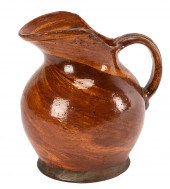 AMERICAN REDWARE PRESENTATION
AMERICAN REDWARE PRESENTATION PITCHERscroddle ware; diagonal marbleized finish; incised "Mrs. Sarah E. [illegible] / Aug 21 1878 / A Nice Present"; Provenance: The Estate of Sally Rhodes, Corona Del Mar, CA; 9 1/2 inches high Condition:
AMERICAN REDWARE PRESENTATION
AMERICAN REDWARE PRESENTATION PITCHERscroddle ware; diagonal marbleized finish; incised "Mrs. Sarah E. [illegible] / Aug 21 1878 / A Nice Present"; Provenance: The Estate of Sally Rhodes, Corona Del Mar, CA; 9 1/2 inches high Condition: -
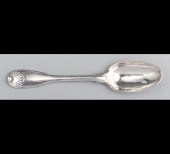 FRENCH PROVINCIAL .950 SILVER
FRENCH PROVINCIAL .950 SILVER TABLESPOONFrench Provincial.950 Silver Tablespoon, mark of Marc Lalanne, town of Blaye in the Bordeaux region, 1780-89, fiddle shell pattern, the reverse of handle engraved with inscription "Sarah Elliot / to the Church / in Federal Street / 1803", marked on reverse, length 7 7/8 in., weight 2.85 troy ozs. Provenance: Sarah Elliot (d. 1805), widow of Simon Elliot (d. 1793), tobacconist of Boston. Christie's New York, Important Furniture, Silver and Folk Art, Jan. 19, 2002, lot 333. Ref.: See Tardy International Hallmarks on Silver, p. 146 Blaye, communautes mark
FRENCH PROVINCIAL .950 SILVER
FRENCH PROVINCIAL .950 SILVER TABLESPOONFrench Provincial.950 Silver Tablespoon, mark of Marc Lalanne, town of Blaye in the Bordeaux region, 1780-89, fiddle shell pattern, the reverse of handle engraved with inscription "Sarah Elliot / to the Church / in Federal Street / 1803", marked on reverse, length 7 7/8 in., weight 2.85 troy ozs. Provenance: Sarah Elliot (d. 1805), widow of Simon Elliot (d. 1793), tobacconist of Boston. Christie's New York, Important Furniture, Silver and Folk Art, Jan. 19, 2002, lot 333. Ref.: See Tardy International Hallmarks on Silver, p. 146 Blaye, communautes mark -
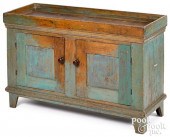 PENNSYLVANIA PAINTED PINE
PENNSYLVANIA PAINTED PINE DRYSINK, 19TH C.Pennsylvania painted pine drysink, 19th c. , retaining an old blue green surface, 33 1/2" h., 49" w. Provenance: The Collection of Russ and Sarah Ezzell, State College, Pennsylvania. Condition: 18" d. Expected wear. Loss to one front foot. Hinge side board of right door replaced. Pulls replaced. Hole cutout in center of backboards.
PENNSYLVANIA PAINTED PINE
PENNSYLVANIA PAINTED PINE DRYSINK, 19TH C.Pennsylvania painted pine drysink, 19th c. , retaining an old blue green surface, 33 1/2" h., 49" w. Provenance: The Collection of Russ and Sarah Ezzell, State College, Pennsylvania. Condition: 18" d. Expected wear. Loss to one front foot. Hinge side board of right door replaced. Pulls replaced. Hole cutout in center of backboards. -
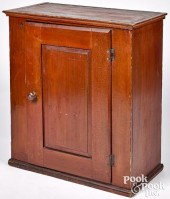 PENNSYLVANIA STAINED POPLAR HANGING
PENNSYLVANIA STAINED POPLAR HANGING CUPBOARDPennsylvania stained poplar hanging cupboard, 19th c. , retaining an old red surface, 31 1/2" h., 26 1/4" w. Provenance: The Collection of Russ and Sarah Ezzell, State College, Pennsylvania. Condition: Overall good condition. Missing one shelf.
PENNSYLVANIA STAINED POPLAR HANGING
PENNSYLVANIA STAINED POPLAR HANGING CUPBOARDPennsylvania stained poplar hanging cupboard, 19th c. , retaining an old red surface, 31 1/2" h., 26 1/4" w. Provenance: The Collection of Russ and Sarah Ezzell, State College, Pennsylvania. Condition: Overall good condition. Missing one shelf. -
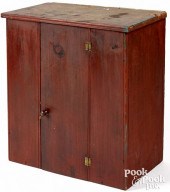 PAINTED PINE HANGING CUPBOARD, 19TH
PAINTED PINE HANGING CUPBOARD, 19TH C.Painted pine hanging cupboard, 19th c. , retaining its original red surface, 25" h., 21 3/4" w. Provenance: The Collection of Russ and Sarah Ezzell, State College, Pennsylvania. Condition: Good condition. Some blue paint residue along right side.
PAINTED PINE HANGING CUPBOARD, 19TH
PAINTED PINE HANGING CUPBOARD, 19TH C.Painted pine hanging cupboard, 19th c. , retaining its original red surface, 25" h., 21 3/4" w. Provenance: The Collection of Russ and Sarah Ezzell, State College, Pennsylvania. Condition: Good condition. Some blue paint residue along right side. -
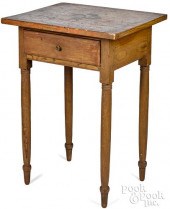 PENNSYLVANIA SHERATON PAINTED
PENNSYLVANIA SHERATON PAINTED ONE-DRAWER STANDPennsylvania Sheraton painted poplar one-drawer stand, 19th c. , retaining its original ochre surface with philphlot on top, 31" h., 22" w. Provenance: The Collection of Russ and Sarah Ezzell, State College, Pennsylvania. Condition: Good condition with expected wear.
PENNSYLVANIA SHERATON PAINTED
PENNSYLVANIA SHERATON PAINTED ONE-DRAWER STANDPennsylvania Sheraton painted poplar one-drawer stand, 19th c. , retaining its original ochre surface with philphlot on top, 31" h., 22" w. Provenance: The Collection of Russ and Sarah Ezzell, State College, Pennsylvania. Condition: Good condition with expected wear. -
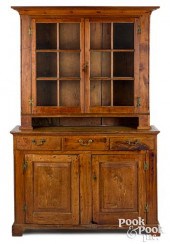 WALNUT TWO-PART DUTCH CUPBOARD, CA.
WALNUT TWO-PART DUTCH CUPBOARD, CA. 1800Walnut two-part Dutch cupboard, ca. 1800 , probably Southern, 82" h., 50" w. Provenance: The Collection of Russ and Sarah Ezzell, State College, Pennsylvania. Condition: Upper case - 11" d. Lower case - 18" d. Probably made in Pennsylvania. Hinges replaced. One pane cracked. Top element of cornice replaced. Patch along bottom of left side of upper section. Middle drawer replaced. Front feet ended out 1". Rear feet ended out 2-3".
WALNUT TWO-PART DUTCH CUPBOARD, CA.
WALNUT TWO-PART DUTCH CUPBOARD, CA. 1800Walnut two-part Dutch cupboard, ca. 1800 , probably Southern, 82" h., 50" w. Provenance: The Collection of Russ and Sarah Ezzell, State College, Pennsylvania. Condition: Upper case - 11" d. Lower case - 18" d. Probably made in Pennsylvania. Hinges replaced. One pane cracked. Top element of cornice replaced. Patch along bottom of left side of upper section. Middle drawer replaced. Front feet ended out 1". Rear feet ended out 2-3". -
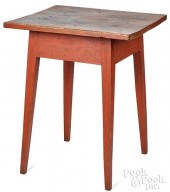 PAINTED PINE SPLAY LEG STAND,
PAINTED PINE SPLAY LEG STAND, 19TH C.Painted pine splay leg stand, 19th c. , retaining an old salmon surface, 29 1/2" h., 24 1/2" w. Provenance: The Collection of Russ and Sarah Ezzell, State College, Pennsylvania. Condition: Good condition. Tight age crack across top.
PAINTED PINE SPLAY LEG STAND,
PAINTED PINE SPLAY LEG STAND, 19TH C.Painted pine splay leg stand, 19th c. , retaining an old salmon surface, 29 1/2" h., 24 1/2" w. Provenance: The Collection of Russ and Sarah Ezzell, State College, Pennsylvania. Condition: Good condition. Tight age crack across top. -
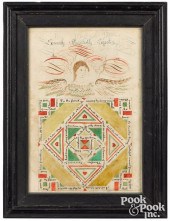 PENNSYLVANIA FRAKTUR LOVERS
PENNSYLVANIA FRAKTUR LOVERS KNOTPennsylvania ink and watercolor fraktur lovers knot, 19th c. , inscribed Sarah Elizabeth Spots , 10 3/4" x 7 1/4". Provenance: A Central Pennsylvania Collector. Competitive in-house shipping is available for this lot. Condition: Minor staining. 1'' patch bottom left corner. A couple small reinforced tears to edges.
PENNSYLVANIA FRAKTUR LOVERS
PENNSYLVANIA FRAKTUR LOVERS KNOTPennsylvania ink and watercolor fraktur lovers knot, 19th c. , inscribed Sarah Elizabeth Spots , 10 3/4" x 7 1/4". Provenance: A Central Pennsylvania Collector. Competitive in-house shipping is available for this lot. Condition: Minor staining. 1'' patch bottom left corner. A couple small reinforced tears to edges. -
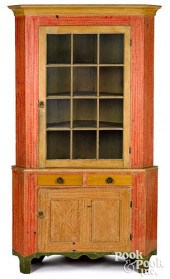 PENNSYLVANIA PAINTED TWO-PART
PENNSYLVANIA PAINTED TWO-PART CORNER CUPBOARDCentre County, Pennsylvania painted two-part corner cupboard, early 19th c. , retaining its original decoration with yellow moldings and door, the case with a sponged salmon ground and green feet, 88" h., 47" w. Pictured in Antique Collection magazine, August 1979, page 25. Exhibited at Heritage Sampler: An Introduction to the Domestic Arts and Crafts of Central, Pennsylvania July-September 1979, Museum of Art, The Pennsylvania State University. Provenance: The Collection of Russ and Sarah Ezzell, State College, Pennsylvania. Condition: Patches to doors at pulls. Drawer facings repainted. Some touch-up to upper door and cornice.
PENNSYLVANIA PAINTED TWO-PART
PENNSYLVANIA PAINTED TWO-PART CORNER CUPBOARDCentre County, Pennsylvania painted two-part corner cupboard, early 19th c. , retaining its original decoration with yellow moldings and door, the case with a sponged salmon ground and green feet, 88" h., 47" w. Pictured in Antique Collection magazine, August 1979, page 25. Exhibited at Heritage Sampler: An Introduction to the Domestic Arts and Crafts of Central, Pennsylvania July-September 1979, Museum of Art, The Pennsylvania State University. Provenance: The Collection of Russ and Sarah Ezzell, State College, Pennsylvania. Condition: Patches to doors at pulls. Drawer facings repainted. Some touch-up to upper door and cornice. -
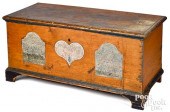 PENNSYLVANIA PAINTED PINE DOWER
PENNSYLVANIA PAINTED PINE DOWER CHEST, DATED 1808Pennsylvania painted pine dower chest, dated 1808 , inscribed Daniel Seider , retaining traces of its original sponge decorated panels, 23" h., 47 1/2" w. Provenance: The Collection of Russ and Sarah Ezzell, State College, Pennsylvania. Condition: Lock catch broken. Hinges a little loose. Patches and repairs to front feet. Rear feet are simple replacements.
PENNSYLVANIA PAINTED PINE DOWER
PENNSYLVANIA PAINTED PINE DOWER CHEST, DATED 1808Pennsylvania painted pine dower chest, dated 1808 , inscribed Daniel Seider , retaining traces of its original sponge decorated panels, 23" h., 47 1/2" w. Provenance: The Collection of Russ and Sarah Ezzell, State College, Pennsylvania. Condition: Lock catch broken. Hinges a little loose. Patches and repairs to front feet. Rear feet are simple replacements. -
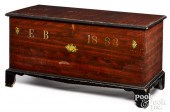 SOAP HOLLOW SOMERSET COUNTY,
SOAP HOLLOW SOMERSET COUNTY, PAINTED BLANKET CHESTSoap Hollow Somerset County, Pennsylvania painted poplar blanket chest, dated 1883 , initialed EB , retaining its original floral decoupage decoration on a red and black grained ground, 24 3/4" h., 48 1/4" w. Provenance: The Collection of Russ and Sarah Ezzell, State College, Pennsylvania. Condition: Overall good condition with minor surface imperfections. A couple repaired cracks to feet.
SOAP HOLLOW SOMERSET COUNTY,
SOAP HOLLOW SOMERSET COUNTY, PAINTED BLANKET CHESTSoap Hollow Somerset County, Pennsylvania painted poplar blanket chest, dated 1883 , initialed EB , retaining its original floral decoupage decoration on a red and black grained ground, 24 3/4" h., 48 1/4" w. Provenance: The Collection of Russ and Sarah Ezzell, State College, Pennsylvania. Condition: Overall good condition with minor surface imperfections. A couple repaired cracks to feet. -
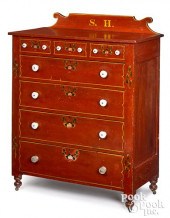 SOAP HOLLOW STYLE PAINTED CHERRY
SOAP HOLLOW STYLE PAINTED CHERRY CHEST OF DRAWERSSoap Hollow style painted cherry chest of drawers, late 19th c. , probably Ohio or Indiana, retaining its original floral decoration on a red ground, the backsplash initialed S.H ., 55" h., 39 1/2" w. Provenance: The Collection of Russ and Sarah Ezzell, State College, Pennsylvania. Condition: Overall good condition. Minor surface imperfections.
SOAP HOLLOW STYLE PAINTED CHERRY
SOAP HOLLOW STYLE PAINTED CHERRY CHEST OF DRAWERSSoap Hollow style painted cherry chest of drawers, late 19th c. , probably Ohio or Indiana, retaining its original floral decoration on a red ground, the backsplash initialed S.H ., 55" h., 39 1/2" w. Provenance: The Collection of Russ and Sarah Ezzell, State College, Pennsylvania. Condition: Overall good condition. Minor surface imperfections.
...many more examples with full details are available to our members - Learn more


